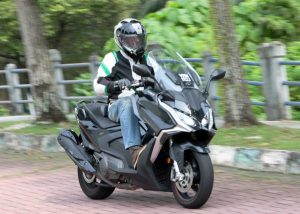PUTRAJAYA: While there’s significant buzz about electric vehicles currently, three hydrogen cars are set to hit the road in Peninsular Malaysia by the first quarter of 2025.
This is part of Malaysia’s ambitious plan to transform the automotive market to have an equal composition of petrol-fuelled cars, hydrogen cars and electric vehicles (EVs) by 2050.
Also to be introduced with the hydrogen cars or fuel-cell cars are the country’s first mobile hydrogen refuelling stations, said Science, Technology and Innovation Minister Chang Lih Kang.
“This initiative is a step towards establishing Malaysia as a leader in clean energy in the region.
“The vision for a Hydrogen Economy positions hydrogen as a clean, low-carbon energy source that is capable of replacing traditional fossil fuels and becoming a key component of a clean energy portfolio.
“As a carbon-neutral energy source, hydrogen offers inclusivity and benefits for industry stakeholders,” he told The Star.

Chang at the helm of a Mirai.
Chang said his ministry was bringing in three Toyota Mirai as part of its hydrogen vehicle test project, of which one would be used at the ministry.
The Mirai is a Fuel Cell Electric Vehicle (FCEV) that generates electricity using hydrogen for propulsion, with water as a by-product and without any carbon emissions.
“We will bring in the Mirai and conduct promotional activities. This will serve as a demonstration of our capability, proving that it is road-ready and can be used effectively,” said Chang.
He emphasised the need to simultaneously promote both EVs and hydrogen vehicles, as green hydrogen released only water vapour and left no residue in the air.
“The three hydrogen cars introduced in Peninsular Malaysia will begin trial runs with mobile refuelling stations to be set up in Putrajaya or Cyberjaya areas.
“The total budget for the Mobile Hydrogen Refueling Station (MHRS) cyber project is around RM12mil, with higher initial cost as it’s the first in the peninsula,” he added.
Chang said additional safety measures, like a purging system to reduce hydrogen concentration in case of a leak and specific instruments for detecting hydrogen leaks, are incorporated into the refuelling station design.
In October last year, Chang said the ministry was developing a Hydrogen Economy and Technology Roadmap (HETR) to strategically position Malaysia within the lucrative global hydrogen ecosystem.
He said by 2050, the global green hydrogen market is projected to reach US$189.19bil (RM834.33bil).

“The hydrogen economy is seen as a viable solution to Malaysia’s economic challenges, which include plans to phase out petrol subsidies,” he added.
It has been reported that according to the reserves life index, Malaysia’s oil and gas reserves may last only another 15 years, signalling an urgent need for change.
“The government plans to implement targeted fuel subsidy schemes next year.
“While Malaysia is advancing in hydrogen technology, hydrogen cars, however, may not become widespread in the country within the next decade,” said Chang.
“As Malaysia does not produce hydrogen passenger vehicles locally, the country has to rely on imports from overseas manufacturers, which are currently limited to the Toyota Mirai and Hyundai Nexo.
“There is, however, rapid development in freight transportation with fuel cell technology, with companies like Hyzon, Hyundai and Nikola making significant progress,” he added.
“Malaysia’s hydrogen economy ambitions extend beyond just mobility, encompassing the entire hydrogen value chain.

“We aim to develop hydrogen production, transportation, storage and end-use in industries, power generation and transportation,” he said.
Currently, the Toyota Mirai is priced at between RM300,000 and RM400,000.
Discussing the features of hydrogen cars, Chang noted that refuelling would take about five minutes, similar to filling up a standard petrol car.
The cost depends on hydrogen production, compression and cooling. Currently, green hydrogen production costs about US$6 (about RM28.15) per kg. Filling up a Mirai would require 5.65kg of hydrogen, costing about US$33.90 (about RM159) for a range of 800km.
With the government planning to gradually remove broad fuel subsidies and switch to targeted subsidies, Chang said it would gradually narrow the cost gap between fuel for new energy vehicles and petrol cars.
He also said that with the introduction of the roadmap last year, hydrogen-powered car purchases would be exempt from import duties, local taxes and road taxes, similar to the incentives provided for EVs.
Additionally, there would be subsidies for buying hydrogen cars, akin to the support China offers for promoting EVs.
Malaysia is working towards phasing out grey hydrogen and transitioning to blue hydrogen, with the ultimate goal of adopting green hydrogen.
This transition aims to reduce dependency on fossil fuel-based hydrogen and mitigate climate change effects through zero-carbon footprint initiatives.
(Grey hydrogen is produced from natural gas and emits carbon waste, blue hydrogen is the same but uses carbon capture and storage to reduce emissions, while green hydrogen – also known as clean hydrogen – is produced from renewable energy sources and does not emit any carbon).
On a related matter, Chang said Malaysia’s first solid-state hydrogen reactor for sustainable electricity generation in rural areas will be launched in the first quarter of 2025.
The 5kW reactor will be deployed in Tanjung Malim, Perak.
“The pilot project is the third initiative using solid-state hydrogen to generate electricity in remote locations, particularly where there is no existing power supply,” he said.
The hydrogen reactor, he said, is intended to power the community hall for the Orang Asli, with expansion to clinics if the deployment is successful.
“The programme aims to provide energy solutions to rural areas in Malaysia that lacked access to the national grid.
“The capacity of 5kW is suitable for smaller-scale electricity needs. Once it is successful, we can consider scaling up,” he said.
Chang also said if Malaysia succeeds in its hydrogen roadmap, it could enter the international green hydrogen market, securing a strong global position. — KHOO GEK SAN












